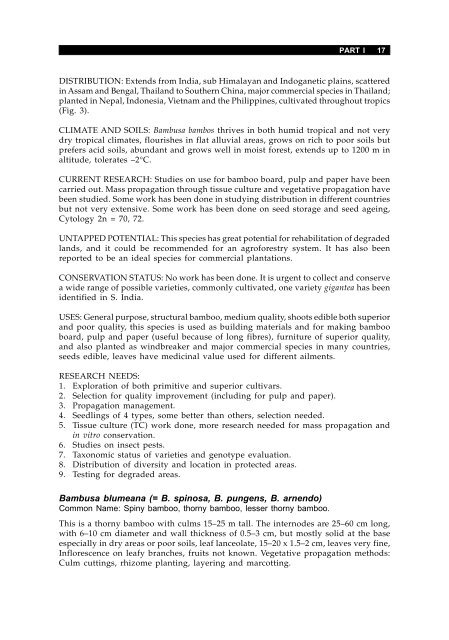Priority species of bamboo and rattan - Bioversity International
Priority species of bamboo and rattan - Bioversity International
Priority species of bamboo and rattan - Bioversity International
Create successful ePaper yourself
Turn your PDF publications into a flip-book with our unique Google optimized e-Paper software.
DISTRIBUTION: Extends from India, sub Himalayan <strong>and</strong> Indoganetic plains, scattered<br />
in Assam <strong>and</strong> Bengal, Thail<strong>and</strong> to Southern China, major commercial <strong>species</strong> in Thail<strong>and</strong>;<br />
planted in Nepal, Indonesia, Vietnam <strong>and</strong> the Philippines, cultivated throughout tropics<br />
(Fig. 3).<br />
CLIMATE AND SOILS: Bambusa bambos thrives in both humid tropical <strong>and</strong> not very<br />
dry tropical climates, flourishes in flat alluvial areas, grows on rich to poor soils but<br />
prefers acid soils, abundant <strong>and</strong> grows well in moist forest, extends up to 1200 m in<br />
altitude, tolerates –2°C.<br />
CURRENT RESEARCH: Studies on use for <strong>bamboo</strong> board, pulp <strong>and</strong> paper have been<br />
carried out. Mass propagation through tissue culture <strong>and</strong> vegetative propagation have<br />
been studied. Some work has been done in studying distribution in different countries<br />
but not very extensive. Some work has been done on seed storage <strong>and</strong> seed ageing,<br />
Cytology 2n = 70, 72.<br />
UNTAPPED POTENTIAL: This <strong>species</strong> has great potential for rehabilitation <strong>of</strong> degraded<br />
l<strong>and</strong>s, <strong>and</strong> it could be recommended for an agr<strong>of</strong>orestry system. It has also been<br />
reported to be an ideal <strong>species</strong> for commercial plantations.<br />
CONSERVATION STATUS: No work has been done. It is urgent to collect <strong>and</strong> conserve<br />
a wide range <strong>of</strong> possible varieties, commonly cultivated, one variety gigantea has been<br />
identified in S. India.<br />
USES: General purpose, structural <strong>bamboo</strong>, medium quality, shoots edible both superior<br />
<strong>and</strong> poor quality, this <strong>species</strong> is used as building materials <strong>and</strong> for making <strong>bamboo</strong><br />
board, pulp <strong>and</strong> paper (useful because <strong>of</strong> long fibres), furniture <strong>of</strong> superior quality,<br />
<strong>and</strong> also planted as windbreaker <strong>and</strong> major commercial <strong>species</strong> in many countries,<br />
seeds edible, leaves have medicinal value used for different ailments.<br />
RESEARCH NEEDS:<br />
1. Exploration <strong>of</strong> both primitive <strong>and</strong> superior cultivars.<br />
2. Selection for quality improvement (including for pulp <strong>and</strong> paper).<br />
3. Propagation management.<br />
4. Seedlings <strong>of</strong> 4 types, some better than others, selection needed.<br />
5. Tissue culture (TC) work done, more research needed for mass propagation <strong>and</strong><br />
in vitro conservation.<br />
6. Studies on insect pests.<br />
7. Taxonomic status <strong>of</strong> varieties <strong>and</strong> genotype evaluation.<br />
8. Distribution <strong>of</strong> diversity <strong>and</strong> location in protected areas.<br />
9. Testing for degraded areas.<br />
Bambusa blumeana (= B. spinosa, B. pungens, B. arnendo)<br />
Common Name: Spiny <strong>bamboo</strong>, thorny <strong>bamboo</strong>, lesser thorny <strong>bamboo</strong>.<br />
PART I 17<br />
This is a thorny <strong>bamboo</strong> with culms 15–25 m tall. The internodes are 25–60 cm long,<br />
with 6–10 cm diameter <strong>and</strong> wall thickness <strong>of</strong> 0.5–3 cm, but mostly solid at the base<br />
especially in dry areas or poor soils, leaf lanceolate, 15–20 x 1.5–2 cm, leaves very fine,<br />
Inflorescence on leafy branches, fruits not known. Vegetative propagation methods:<br />
Culm cuttings, rhizome planting, layering <strong>and</strong> marcotting.

















